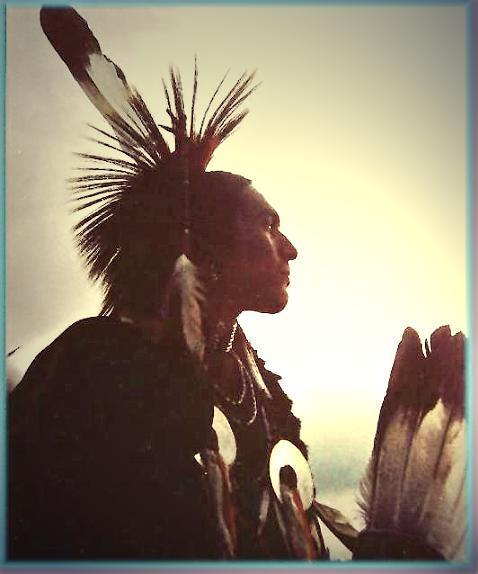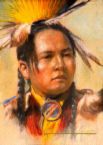|
|
 |
|
|
 |
|
The Story
|
Kokopelli is a prehistoric deity depicted
hundreds of times in rock art, some of it over a thousand years old, located in numerous sites in southwestern United States
deserts and mountains. Often depicted as a humpbacked flute player, this mythic being has survived in recognizable form from
Anasazi times to the present. There is something appealing about Kokopelli which fascinates all kinds of people, even in our
modern technological age. |
Kokopelli Vignette
by Frontier Studios

|
The Anasazi or "Ancient Ones" were
primarily farmers, growing corn, beans, and squash in the Four Corners area on the Colorado Plateau. Both the Basketmaker
Period (dating at least from about 200 B.C.) and the Pueblo Period (dating from about 700 A.D.) include the humpbacked flute
player among their deities or supernaturals. Long-distance trade networks and migrations from Mexico apparently helped spread
cultural and religious elements, so that by 1500 A.D. fluteplayer images were also included in the Hohokam, Mogollon, and
Fremont cultures, in petroglyphs (rock carving), pictographs (rock painting), kiva murals, ceramics and baskets. Today, Kokopelli
is one of the Hopi kachinas, and is in many traditional stories and songs of Native Americans of the desert southwest.
The Sacred Formulas of the Cherokee, published in the 7th Annual report, Bureau of American Ethnology, is a summary of the work Mooney did in preserving
a set of Cherokee Shaman's notebooks. This text is a look into the shamanistic practices of healers among the Cherokee, including
the full text in Cherokee and English of several key rituals.
*CHEROKEE BALL*
Among their other many cultural gifts to the world,
Native Americans contributed the game which later became known as Lacrosse. The Cherokee Ball Play vividly describes
the ethnography of this sport with particular attention to its ritual significance.
This sport served as means of community social cohesion,
an occasion for some big wagers, a surrogate for battle with other villages, and sounds like a great deal of fun. Many of
the ceremonial aspects will be familiar to anyone involved with High School football. Some of the practices required a very
high tolerance for pain. On a spiritual level the game is a magical battle between shamans, and the rituals and ceremonies
used to gain advantage are of great interest. The Native People taught the whites to be one with nature, how to live off the
land.....and then they took our borrowed land. The earth is our mother, the Creator our Father and land is not owned
but barrowed from the Great Spirit or Creator as God is known to us natives.
|
 |
|
One for you All
Bear Story
In the long ago time, there was a Cherokee Clan call the
Ani-Tsa-gu-hi (Ahnee-Jah-goo-hee), and in one family of this clan was a boy who used to leave home and be gone all day in
the mountains. After a while he went oftener and stayed longer, until at last he would not eat in the house at all, but started
off at daybreak and did not come back until night. His parents scolded, but that did no good, and the boy still went every
day until they noticed that long brown hair was beginning to grow out all over his body. Then they wondered and asked him
why it was that he wanted to be so much in the woods that he would not even eat at home. Said the boy, "I find plenty to eat
there, and it is better than the corn and beans we have in the settlements, and pretty soon I am going into the woods to say
all the time." His parents were worried and begged him not leave them, but he said, "It is better there than here, and you
see I am beginning to be different already, so that I can not live here any longer. If you will come with me, there is plenty
for all of us and you will never have to work for it; but if you want to come, you must first fast seven days."
The father and mother talked it over and then told the headmen
of the clan. They held a council about the matter and after everything had been said they decided: "Here we must work hard
and have not always enough. There he says is always plenty without work. We will go with him." So they fasted seven days,
and on the seventh morning al the Ani-Tsa-gu-hi left the settlement and started for the mountains as the boy led the way.
When the people of the other towns heard of it they were
very sorry and sent their headmen to persuade the Ani Tsaguhi to stay at home and not go into the woods to live. The messengers
found them already on the way, and were surprised to notice that their bodies were beginning to be covered with hair like
that of animals, because for seven days they had not taken human food and their nature was changing. The Ani Tsaguhi would
not come back, but said, "We are going where there is always plenty to eat. Hereafter we shall be called Yonv(a) (bears),
and when you yourselves are hungry come into the woods and call us and we shall shall come to give you our own flesh. You
need not be afraid to kill us, for we shall live always." Then they taught the messengers the songs with which to call them
and bear hunters have these songs still. When they had finished the songs, the Ani Tsaguhi started on again and the messengers
turned back to the settlements, but after going a little way they looked back and saw a drove of bears going into the woods.
Aho! We are all Related!
|
 |
|
More Myths
At one time, animals and people lived together peaceably and talked with each other. But when mankind began to multiply
rapidly, the animals were crowded into forests and deserts.
Man began to destroy animals wholesale for their skins and furs, not just for needed food. Animals became angry at such
treatment by their former friends, resolving they must punish mankind.
The bear tribe met in council, presided over by Old White Bear, their Chief. After several bears had spoken against mankind
for their bloodthirsty ways, war was unanimously agreed upon. But what kinds of weapons should the bears use?
Chief Old White Bear suggested that man's weapon, the bow and arrow, should be turned against him. All of the council agreed.
While the bears worked and made bows and arrows, they wondered what to do about bowstrings. One of the bears sacrificed himself
to provide the strings, while the others searched for good arrow- wood.
When the first bow was completed and tried, the bear's claws could not release the strings to shoot the arrow. One bear
offered to cut his claws, but Chief Old White Bear would not allow him to do that, because without claws he could not climb
trees for food and safety. He might starve.
The deer tribe called together its council led by Chief Little Deer. They decided that any Indian hunters, who killed deer
without asking pardon in a suitable manner, should be afflicted with painful rheumatism in their joints.
After this decision, Chief Little Deer sent a messenger to their nearest neighbours, the Cherokee Indians.
"From now on, your hunters must first offer a prayer to the deer before killing him," said the messenger. "You must ask
his pardon, stating you are forced only by the hunger needs of your tribe to kill the deer. Otherwise, a terrible disease
will come to the hunter."
When a deer is slain by an Indian hunter, Chief Little Deer will run to the spot and ask the slain deer's spirit, "Did
you hear the hunter's prayer for pardon?"
If the reply is yes, then all is well and Chief Little Deer returns to his cave. But if the answer is no, then the Chief
tracks the hunter to his lodge and strikes him with the terrible disease of rheumatism, making him a helpless cripple unable
to hunt again.
All the fishes and reptiles then held a council and decided they would haunt those Cherokee Indians, who tormented them,
by telling them hideous dreams of serpents twining around them and eating them alive. These snake and fish dreams occurred
often among the Cherokees. To get relief, the Cherokees pleaded with their Shaman to banish their frightening dreams if they
no longer tormented the snakes and fish.
Now when the friendly plants heard what the animals had decided against mankind, they planned a countermove of their own.
Each tree, shrub, herb, grass, and moss agreed to furnish a cure for one of the diseases named by the animals and insects.
Thereafter, when the Cherokee Indians visited their Shaman about their ailments and if the medicine man was in doubt, he
communed with the spirits of the plants. They always suggested a proper remedy for mankind's diseases.
This was the beginning of plant medicine from nature among the Cherokee Indian nation a long, long time ago.
 We must look to the future of the Native Peoples.
|
 |
|
|
|
|
|
|
 |

